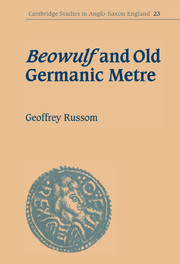Book contents
- Frontmatter
- Contents
- Preface
- List of abbreviation
- 1 Introduction
- 2 The foot
- 3 The verse
- 4 Light feet and extrametrical words
- 5 Metrical archaisms
- 6 Alliteration
- 7 Metrical subordination within the foot
- 8 Resolution
- 9 Word order and stress within the clause
- 10 Old Saxon alliterative verse
- 11 Hildebrandslied
- 12 Conclusions
- Appendix: Rule summary
- Bibliography
- Index
- Verses specially discussed
9 - Word order and stress within the clause
Published online by Cambridge University Press: 02 November 2009
- Frontmatter
- Contents
- Preface
- List of abbreviation
- 1 Introduction
- 2 The foot
- 3 The verse
- 4 Light feet and extrametrical words
- 5 Metrical archaisms
- 6 Alliteration
- 7 Metrical subordination within the foot
- 8 Resolution
- 9 Word order and stress within the clause
- 10 Old Saxon alliterative verse
- 11 Hildebrandslied
- 12 Conclusions
- Appendix: Rule summary
- Bibliography
- Index
- Verses specially discussed
Summary
The Light Foot Rule (R6) incorporates Kuhn's observations about clustering of unstressed Satzpartikeln at the level of the verse. We must now consider why unstressed Satzpartikeln tend to occupy the first verse of the clause, in Old Norse as well as Old English poems. It is worth emphasizing that Kuhn's laws do not mandate word orders unattested in the early Germanic prose that survives to us. K1–2 simply declare certain word orders attested in prose to be unacceptable in verse. Since rules of poetic metre perform a similar function, we have no aprioristic basis for attributing the Kuhn's-law effects to archaic syntax. There is nothing archaic about the way in which Kuhn's laws operate. General linguistic principles suffice to explain why Satzpartikeln often appear as proclitics to the Germanic clause or to the verb phrase, the major subconstituent of the clause. Research on Old English by theoretical linguists indicates that the Kuhn's-law effects are simply exaggerations of ordinary-language tendencies. Traugott, for example, observes that movement of unstressed words toward the beginning of the clause is a familiar feature of prose syntax and is supported by a tendency to move heavy constituents in the opposite direction. Our primary task, then, is to explain why a familiar type of optional movement became obligatory for Germanic poets, or very nearly so. We will also need to deal with exceptions to Kuhn's second law in verses with finite verbs.
- Type
- Chapter
- Information
- Beowulf and Old Germanic Metre , pp. 118 - 135Publisher: Cambridge University PressPrint publication year: 1998

